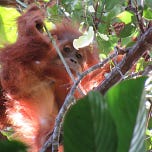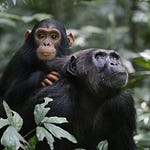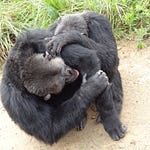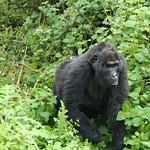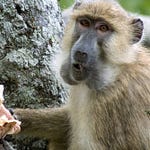High in the tangled treetops of northern Sumatra, young orangutans watch their mothers with careful intent. Each movement matters: the bending of a branch, the weaving of leaves, the deliberate choice of tree. Over years of apprenticeship, these observations become skills. By adulthood, the young apes have mastered the construction of elaborate night nests, platforms that keep them dry, warm and safe — feats of arboreal engineering passed down not by instinct, but by culture.
A new study published in Communications Biology1 reports the first long-term evidence that wild orangutans acquire nest-building skills through observational social learning. Drawing on 17 years of fieldwork, researchers found that juvenile orangutans who deliberately watched others — a behavior scientists call “peering” — were far more likely to develop complex nest-building techniques than those who did not.
“Nest-building is critical to survival in orangutans but has rarely been the focus of research,” notes Ani Permana of the University of Warwick, lead author of the study. “This paper shows that the learning process is highly dependent on young animals carefully watching the nest-building of others.”
Why Nests Matter
For a tree-dwelling ape, a nest is more than a bed. It is a safety device, an environmental buffer and a place of rest for bodies adapted to the canopy. Day nests tend to be rudimentary frames, but night nests are intricate constructions built as high as 20 meters above the forest floor. These sleeping platforms often feature linings, pillows, and even roofs fashioned from interwoven branches and leaves. Some studies have found that orangutan nests repel mosquitoes, adding yet another survival advantage.
Until now, scientists knew surprisingly little about how this complex behavior develops. While tool use in chimpanzees has been closely studied, nest-building in great apes has been treated as background behavior — an assumption that it is mostly innate.
How Orangutans Learn to Build
The research team followed multiple generations of Sumatran orangutans, recording which individuals peered at others during nest construction. When immature orangutans observed their mothers building nests, they were more likely to attempt construction themselves. Those who were present but distracted generally did not practice the skill.
“Orangutan nest-building tendency may have some innate basis,” the authors write, “but the details and method must be socially learned starting from a very young age by watching and practicing, learning from mistakes as they grow.”
Immature orangutans focused especially on the most difficult parts of the process — adding comfort elements or spanning multiple trees — and practiced more after these observations. As they matured, they began choosing new role models beyond their mothers, sampling different approaches and tree species. This expanding curiosity mirrored how human adolescents diversify their social worlds before settling into adult preferences.
Know-How and Know-What
The study highlights two dimensions of learning: “know-how” (the techniques of construction) and “know-what” (which materials to use).
“Aside from learning ‘how to’ build a nest, immature orangutans also appear to learn the ‘know-what’ of which materials to use,” explains Caroline Schuppli of the Max Planck Institute of Animal Behavior, senior author of the study.
This combination of technical skill and ecological knowledge creates local traditions. Adults tend to return to the materials their mothers used, suggesting a cultural lineage of nest construction within populations. Such continuity, the researchers argue, represents a form of orangutan culture — one that could vanish if habitats and communities are lost.
Culture in the Trees
Nest-building, unlike tool use, may predate much of the complex behaviors seen in modern apes. If social learning in nest construction stretches deep into our evolutionary past, it hints at how long apes — and possibly our own ancestors — have relied on watching, practicing and passing down skills.
The findings add to a growing recognition that apes live not only in ecological worlds but also in cultural ones, where knowledge flows across generations. Preserving that flow may be as important as conserving the forests themselves.
Related Research
van Casteren, A., Sellers, K. C., et al. (2021). Mechanical properties of orangutan nests and the implications for arboreal locomotion. American Journal of Physical Anthropology, 174(4), 609–623. https://doi.org/10.1002/ajpa.24185
van Schaik, C. P., Ancrenaz, M., Borgen, G., et al. (2003). Orangutan cultures and the evolution of material culture. Science, 299(5603), 102–105. https://doi.org/10.1126/science.1078004
Schuppli, C., Meulman, E. J. M., Forss, S. I. F., et al. (2016). Observational social learning and practice in wild orangutan immatures. Scientific Reports, 6, 30511. https://doi.org/10.1038/srep30511
Permana, A. L., Permana, J. J., Nellissen, L., Prayogi, E. S., Prasetyo, D., Wich, S. A., van Schaik, C. P., & Schuppli, C. (2025). Observational social learning of “know-how” and “know-what” in wild orangutans: evidence from nest-building skill acquisition. Communications Biology, 8(1), 890. https://doi.org/10.1038/s42003-025-08217-2

